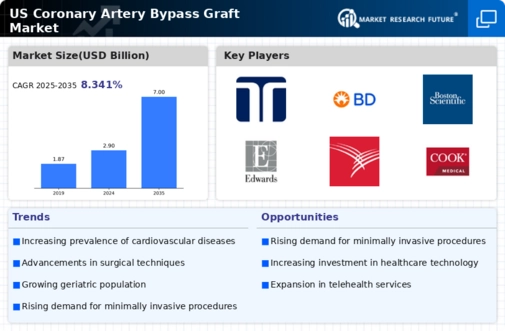Increased Awareness and Education
The heightened awareness and education regarding cardiovascular health are pivotal in driving the coronary artery-bypass-graft market. Public health campaigns and educational initiatives have significantly improved knowledge about heart disease risk factors and the importance of early intervention. As individuals become more informed about their health, they are more likely to seek medical advice and treatment options, including surgical procedures. This trend is reflected in the rising number of patients opting for coronary artery bypass grafting as a viable solution to manage their cardiovascular conditions. Consequently, the coronary artery-bypass-graft market is poised for growth, with projections indicating an increase in procedures performed annually, potentially reaching XX by 2027.
Advancements in Surgical Techniques
Innovations in surgical techniques and technologies are significantly influencing the coronary artery-bypass-graft market. Minimally invasive procedures, robotic-assisted surgeries, and enhanced imaging technologies have transformed traditional approaches, leading to improved patient outcomes and reduced recovery times. For instance, the adoption of off-pump coronary artery bypass grafting has gained traction, allowing surgeons to perform procedures without stopping the heart. This advancement not only minimizes complications but also enhances the overall efficiency of surgeries. As these techniques become more prevalent, the coronary artery-bypass-graft market is expected to expand, with a projected growth rate of approximately XX% over the next five years, driven by the increasing preference for less invasive options.
Rising Prevalence of Cardiovascular Diseases
The increasing incidence of cardiovascular diseases in the US is a primary driver for the coronary artery-bypass-graft market. According to the American Heart Association, nearly 697,000 individuals succumbed to heart disease in 2020, highlighting a critical health concern. This alarming trend necessitates effective surgical interventions, including coronary artery bypass grafting, to restore blood flow and improve patient outcomes. As the population ages, the prevalence of conditions such as coronary artery disease is expected to rise, further propelling the demand for surgical procedures. The coronary artery-bypass-graft market is likely to experience growth as healthcare providers seek to address this pressing issue, with an estimated market value projected to reach $XX billion by 2027.
Regulatory Support and Reimbursement Policies
Regulatory support and favorable reimbursement policies are essential drivers for the coronary artery-bypass-graft market. The US healthcare system has established frameworks that facilitate access to surgical interventions, ensuring that patients receive necessary treatments without significant financial burdens. Medicare and private insurers often cover coronary artery bypass grafting, which encourages patients to pursue these life-saving procedures. Additionally, the FDA's approval of new technologies and devices related to coronary artery bypass grafting further stimulates market growth. As reimbursement policies evolve to support innovative surgical techniques, the coronary artery-bypass-graft market is likely to expand, with an anticipated growth rate of XX% over the next several years.
Growing Investment in Healthcare Infrastructure
The ongoing investment in healthcare infrastructure in the US is a crucial driver for the coronary artery-bypass-graft market. With the expansion of hospitals and surgical centers, there is an increased capacity to perform complex procedures, including coronary artery bypass grafting. The US government and private sector are allocating substantial funds to enhance healthcare facilities, which is likely to improve access to surgical interventions. Furthermore, the integration of advanced medical technologies within these facilities is expected to elevate the quality of care provided. As a result, the coronary artery-bypass-graft market may witness a surge in demand, with estimates suggesting a market growth of XX% as healthcare systems adapt to meet the needs of an aging population.



















Leave a Comment